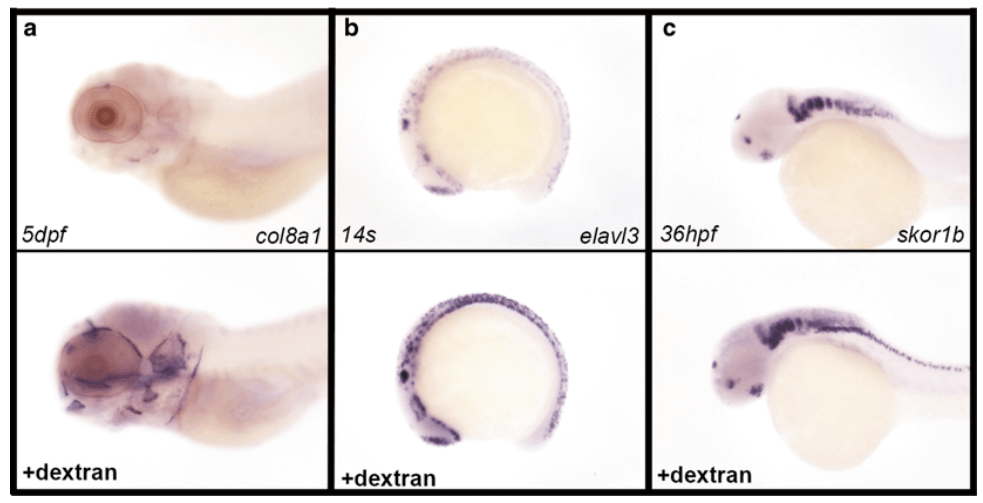Whole mount in situ hybridization (WMISH) is a commonly used technique to determine RNA expression patterns of genes in the context of whole embryos, embryonic fragments or organoids. In this process, synthetically produced RNA probes first bind or “hybridize” to the transcript of the target gene. These RNA hybrids are then detected using immunohistochemistry or fluorescence, revealing spatial and temporal patterns of gene expression. This technique allows spatial assignment of the transcriptional activity of specific genes to cell types, tissues or organs with high resolution. Whole mount ISH is commonly used for embryos from vertebrate (eg, mouse, fish, amphibian) and invertebrate (eg, Drosophila) species. Unlike traditional in situ hybridization techniques, which require the preparation of tissue sections of embryos to facilitate detection of internal structures, whole-mount techniques allow for the assessment of gene expression patterns on whole embryos or structures. During embryonic development, genes involved in organismal morphogenesis are expressed in temporally and spatially restricted patterns, and WMISH technology can help researchers understand the molecular basis of embryonic development.
 Fig 1. 2 Effect of Dextran Sulfate on whole-mount in situ hybridization. (Thisse B, et al. 2014)
Fig 1. 2 Effect of Dextran Sulfate on whole-mount in situ hybridization. (Thisse B, et al. 2014)
Whole-Mount FISH Assay
Our FISH technology service platform provides complete WMISH technology options. These processes include protocol design, sample preparation (whole embryos, embryo fragments or organs), pre-hybridization and hybridization, imaging and data analysis. The design of personalized solutions is mainly carried out for the identification of target sequences in the model organism to be studied. The platform we provide has the custom design and customization capabilities of many different types of probes, and also provides adaptive optimization of FISH testing solutions that are compatible with most commercial probes. Our service platform accepts the customization of Whole-Mount analysis from different model organisms, and provides technical support for sampling and sample preservation to customers. After receiving the customer's sample, it goes through a series of quality control links to ensure that the sample is of high quality for subsequent analysis. Since Whole-Mount FISH is performed on whole embryos or embryo fragments/organs, the complexity of the sample itself has a large impact on the quality of the analysis. With a wealth of knowledge, we are confident to provide you with high-quality Whole-Mount FISH testing services.
Applications
Whole-mount in situ hybridization can be used for gene expression analysis of intermediate hosts for infection and transmission of lethal arboviruses, such as malaria, dengue fever. These studies can be used for transmission blockade and drug design targeting intermediate hosts.
Whole-mount in situ hybridization can be used to characterize changes in gene expression patterns in animal models associated with exposure to teratogenic agents or agents that interfere with fetal development.
Whole-mount in situ hybridization can be used for developmental biology studies in zebrafish models,
Whole-mount in situ hybridization can be used to characterize genes whose expression patterns are altered in animal models exposed to different chemical stimuli.
Whole-mount in situ hybridization can be used to validate phenotypic changes associated with congenital diseases, and combined with phenotypic scoring can facilitate a better understanding of the role of specific mutations in phenotypic changes.
Whole-mount in situ hybridization can be used to characterize the spatial distribution of gene transcripts during embryonic development, defining whether a group of genes share temporal and spatial expression patterns (synchronous expression).
 Fig 2. Whole mount in situ hybridization.
Fig 2. Whole mount in situ hybridization.
Creative Bioarray offers Whole-Mount fluorescence in situ hybridization services to help researchers analyze gene expression on embryos or organs rather than sections. If you are interested in our services, please contact us for cooperation. We look forward to cooperating with you in the near future.
Reference
- Thisse B, Thisse C. In situ hybridization on whole-mount zebrafish embryos and young larvae[M]//In situ hybridization protocols. Humana Press, New York, NY, 2014: 53-67.


 Fig 1. 2 Effect of Dextran Sulfate on whole-mount in situ hybridization. (Thisse B, et al. 2014)
Fig 1. 2 Effect of Dextran Sulfate on whole-mount in situ hybridization. (Thisse B, et al. 2014) Fig 2. Whole mount in situ hybridization.
Fig 2. Whole mount in situ hybridization.


